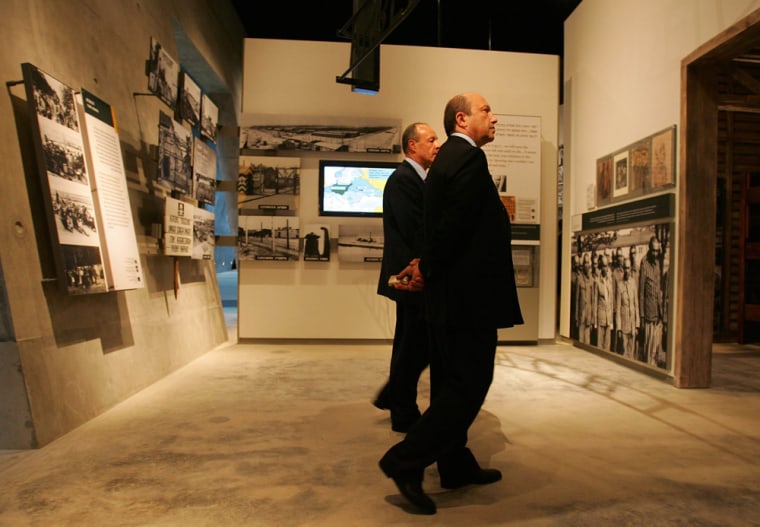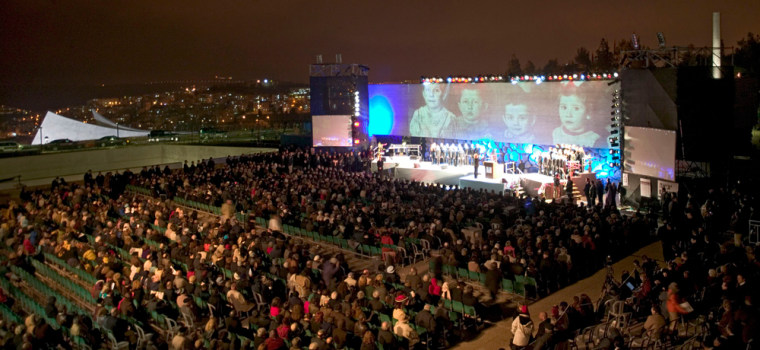Israel’s president warned of renewed anti-Semitism and the U.N. secretary-general urged an unyielding fight against racism during Tuesday’s opening ceremony of a $56 million Holocaust museum that focuses on the personal tragedies of the Nazi genocide.
Leaders from some 40 nations attended the ceremony at the new Holocaust History Museum at Jerusalem’s Yad Vashem memorial, which took 10 years to complete.
The ceremony sought to link the horrors of the genocide with the hope of the survivors and their descendants.
A children’s choir sang as scenes of Jewish children from the war era flashed on a huge screen behind them. A man sounded the shofar, a ritual trumpet made of a ram’s horn, while others played violins and clarinets and sang songs in Hebrew and Yiddish.
“We are concerned about Holocaust denial and anti-Semitism,” Israeli President Moshe Katsav told the crowd, bundled in winter coats for the outdoor ceremony. Europe “must accept the burden of the memory and lessons of the Holocaust for the future it is building. It owes this to the millions of Jews who were murdered on its soil.”
Hundreds of police patrolled Jerusalem to protect the visitors, among them 15 heads of government and state. Major thoroughfares were closed to traffic, snipers were posted on rooftops and a bomb squad carried out numerous sweeps.
Annan: Never again
U.N. Secretary-General Kofi Annan said the main task now is to prevent a repetition of the Holocaust anywhere. “A United Nations that fails to be at the forefront of the fight against anti-Semitism and other forms of racism denies its history and undermines its future,” he told the dignitaries.
Naphtali Lavie, who survived the Auschwitz and Buchenwald concentration camps, said the event marked recognition of the suffering of the Jews. “After 60 years the world woke up a little bit,” he said, “This is something that gives the people the feeling that they are human beings and they deserve the sympathy and recognition of mankind.”
Prime Minister Ariel Sharon, in his address, said “the state of Israel is the only place in the world where the Jews have the right and the power to protect themselves by themselves. This is the only guarantee that the Jewish people will never know another Holocaust.”
Representing Germany
German Foreign Minister Joschka Fischer said the opening of the museum was “a moment of commemoration for the 6 million murdered by Nazi Germany.”

“Of course Germany is my country so it’s also a historical and moral responsibility to never forget what happened and the responsibility of my country for the Shoah,” he said, using the Hebrew word for Holocaust.
New York City Mayor Michael Bloomberg represented the United States. “Freedom is something we constantly have to fight for and if we ever compromise our standards, we see just how far it goes,” he told reporters. “We cannot allow intolerance any place against any people.”
To give a human dimension to Holocaust statistics, some 90 personal stories are woven into the museum’s displays, which also feature some 280 works of art.
A video projected onto the wall of the entrance shows daily Jewish life in Europe in the 1920s and ’30s. Visitors can walk through a typical living room of a Jewish family in Germany in the 1930s. A life-size replica of the Warsaw Ghetto’s Leszno Street features cobblestones, a 1940s tram track and lamp posts replete with shrapnel holes from the Jewish uprising — all donated by the Polish capital.
‘Man’s inhumanity to Jews’
The museum displays a three-tiered wooden barrack where concentration camp inmates slept, a cattle wagon that transported Jews to their deaths and a small fishing boat that ferried Danish Jews to safety in Sweden.
Underground galleries on either side of a 600-foot central walkway topped by a skylight guide visitors through the history of Adolf Hitler’s Final Solution: prewar life, anti-Semitic laws, roundups, deportations, mass executions, death camps.
Nobel Peace prize winner Elie Wiesel, himself an Auschwitz survivor, gave the ceremony’s closing remarks.
“It was man’s inhumanity to man — no. It was man’s inhumanity to Jews. Jews were not killed because they were human beings. In the eyes of the killers, they were not human beings, they were Jews,” he said.
